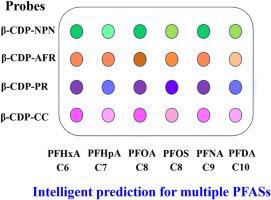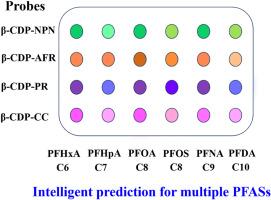结合环糊精荧光传感阵列和机器学习快速筛选和检测全氟烷基物质
IF 6
2区 化学
Q1 CHEMISTRY, ANALYTICAL
引用次数: 0
摘要
背景:全氟烷基物质(PFASs)是具有重大健康风险的持久性环境毒素,饮用水是主要的接触途径。目前通过液相色谱-质谱(LC-MS)进行的金标准检测受到高成本、复杂性和缺乏便携性的阻碍,限制了快速的现场筛选。虽然荧光传感器提供了替代方案,但现有的设计缺乏多路检测能力或需要复杂的制造。为了解决这一问题,我们开发了一种超分子荧光传感器阵列,利用β-环糊精聚合物(β-CDP)和染料探针之间的主客体化学反应,结合机器学习在水中快速筛选多pfas。结果利用β-环糊精聚合物(β-CDP)配合物与4种染料(NPN、AFR、CC、PR)构建了4 × 6传感器阵列。6种PFASs的差异竞争结合产生了独特的荧光响应模式。这些全氟化合物包括全氟辛酸(PFOA)、全氟辛烷磺酸(PFOS)、全氟癸酸(PFDA)、全氟壬酸(PFNA)、全氟庚酸(PFHpA)和全氟己酸(PFHxA)。线性判别分析(LDA)可在10 min内同时对6种PFASs进行判别和定量,检出限分别为38 ng/L (PFOA)和31 ng/L (PFOS)。该阵列在μg/L水平上准确分类PFAS混合物(二元到四元)。模块化深度学习平台量化了真实水样中的PFASs,与LC-MS相比,相对误差仅为0.66%。采用添加5 μg/L PFOA的地表水进行验证,准确度较高(预测值:5.2345 μg/L; LC-MS: 5.2692 μg/L)。本工作建立了主-客体荧光阵列与机器学习相结合,用于多重PFASs检测,克服了单一分析物传感器和实验室绑定仪器的局限性。该方法为现场筛选提供了一个便携、经济的平台,具有lc - ms级的精度,解决了环境监测的迫切需求。其模块化设计可以无缝集成到现场部署的设备中,为快速水质评估和法规遵从性提供了变革潜力。本文章由计算机程序翻译,如有差异,请以英文原文为准。


Integrating cyclodextrin fluorescence sensing array and machine learning for rapid screening and detection of perfluoroalkyl substances
Background
Perfluoroalkyl substances (PFASs) are persistent environmental toxins posing significant health risks, with drinking water being a major exposure route. Current gold-standard detection via liquid chromatography-mass spectrometry (LC-MS) is hindered by high cost, complexity, and lack of portability, limiting rapid on-site screening. While fluorescence sensors offer alternatives, existing designs lack multiplex detection capability or require intricate fabrication. To address this gap, we developed a supramolecular fluorescence sensor array exploiting host-guest chemistry between β-cyclodextrin polymer (β-CDP) and dye probes, integrated with machine learning for rapid multi-PFAS screening in water.
Results
A 4 x 6 sensor array was constructed using β-cyclodextrin polymer (β-CDP) complexes with four dyes (NPN, AFR, CC, PR). Differential competitive binding of six PFASs generated unique fluorescence response patterns. These PFASs included perfluorooctanoic acid (PFOA), perfluorooctane sulfonate (PFOS), perfluorodecanoic acid (PFDA), perfluorononanoic acid (PFNA), perfluoroheptanoic acid (PFHpA), and perfluorohexanoic acid (PFHxA). Linear discriminant analysis (LDA) enabled simultaneous discrimination and quantification of all six PFASs within 10 min, achieving detection limits of 38 ng/L (PFOA) and 31 ng/L (PFOS). The array accurately classified PFAS mixtures (binary to quaternary) at μg/L levels. A modular deep learning platform quantified PFASs in real water samples with only 0.66 % relative error versus LC-MS. Validation using surface water spiked with 5 μg/L PFOA confirmed high accuracy (predicted: 5.2345 μg/L; LC-MS: 5.2692 μg/L).
Significance
This work establishes the host-guest fluorescence array coupled with machine learning for multiplex PFASs detection, overcoming limitations of single-analyte sensors and lab-bound instruments. The method provides a portable, cost-effective platform for on-site screening with LC-MS-level accuracy, addressing urgent needs for environmental monitoring. Its modular design allows seamless integration into field-deployable devices, offering transformative potential for rapid water quality assessment and regulatory compliance.
求助全文
通过发布文献求助,成功后即可免费获取论文全文。
去求助
来源期刊

Analytica Chimica Acta
化学-分析化学
CiteScore
10.40
自引率
6.50%
发文量
1081
审稿时长
38 days
期刊介绍:
Analytica Chimica Acta has an open access mirror journal Analytica Chimica Acta: X, sharing the same aims and scope, editorial team, submission system and rigorous peer review.
Analytica Chimica Acta provides a forum for the rapid publication of original research, and critical, comprehensive reviews dealing with all aspects of fundamental and applied modern analytical chemistry. The journal welcomes the submission of research papers which report studies concerning the development of new and significant analytical methodologies. In determining the suitability of submitted articles for publication, particular scrutiny will be placed on the degree of novelty and impact of the research and the extent to which it adds to the existing body of knowledge in analytical chemistry.
 求助内容:
求助内容: 应助结果提醒方式:
应助结果提醒方式:


